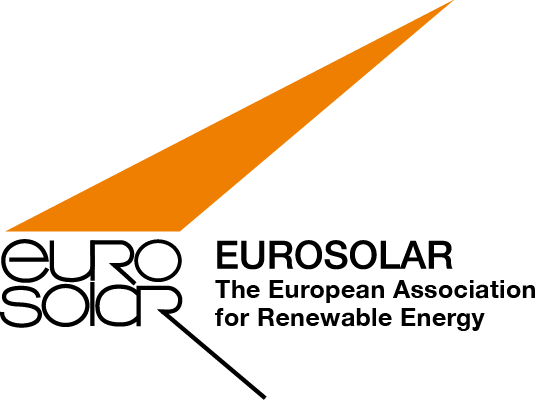EUROSOLAR’s Regenerative Decade shows the acceleration towards a climate-positive economy and regenerative society, essential for sustaining a healthy environment
Everyone is talking about climate neutrality, about ‘Net Zero’ by 2050. Yet such concepts are not only insufficient as goals for society as a whole, and difficult to implement because of their calculative vagueness. They are also set far too late – about 50 years too late. It is as illogical as it is irresponsible to demand climate neutrality with 420 millionths of a part (ppm) of CO2 in the atmosphere today – or probably just under 500 ppm in 2050 – when 280 ppm is the stable level. The demand and action must always be called and mean climate positivity.
Everyone talks about the Paris Climate Agreement – and yet it is equally clear that not only is no country on earth prepared to achieve its goals in the foreseeable future, but also that the Paris Climate Agreement was already aimed at insufficient goals. Two degrees of increase, even 1.5 degrees, were demonstrably too much for the stability of the earth’s ice world, from the Arctic via permafrost to Greenland, via glaciers worldwide to Antarctica: everything began to visibly melt away at only half a degree increase. Today, the average global warming compared to the actual pre-industrial time of 1750 is very likely already over 2 degrees. To gloss over this glaring inconsistency, official reports now only refer to 1860, 1990 and even 2006 as reference years.
Through a combination of skillful delay tactics and a – seemingly scientifically supported – lulling of the public into a sense of security, fossil industries but also some governments have misled themselves, the world, Europe and especially Great Britain’s people for decades.
Previous measures and targets for ‘climate neutrality’ – which continue to emit – in far too long periods of 20 to 30 years are completely inadequate for the climate dynamics. Not only have CO2 emissions risen to today’s 150%, still increasing excess: methane concentrations are already three times higher than a stable climate would tolerate over time: at over 1900 ppb instead of 600. Nevertheless, many still advocate natural gas as a bridge technology. But bridge to where? Methane is the biggest potential risk factor of all among the ongoing missteps: here, threatening things are brewing due to the thawing of Arctic soils, lakes and seabeds.
Even more underestimated in the public debate than the increasing atmospheric methane surplus is the deoxygenation of the atmosphere and oceans, which is slowly but inevitably accelerating under current conditions. Fossil resource combustion is the largest anthropogenic factor here. This currently releases as much CO2 annually as atmospheric oxygen (O2) is destroyed by burning and industrial processes: about 40 Gigatonnes per year – with both figures continuing to rise due to ongoing combustion practices.
This reverses in the blink of an eye the geological process that led to today’s oxygen-rich atmosphere 2.4 billion years ago, which is known to have been necessary for multicellular organisms and, most recently, the development of humans. There are indications that the removal of oxygen accelerated in the course of the increase in CO2 and, due to feedbacks, in a relatively short period of time, even in human history – possibly only a few thousand years – atmospheric oxygen is threatening to collapse, with the suffocation of all O2-dependent life. Only the cessation of fossil carbon emissions and withdrawal of their excess concentrations from the atmosphere through biospheric regeneration and other measures, and permanent sequestration of carbon on a large scale can slow down this process.
The so-called carbon budget – the supposed possibility of emitting ever more waste gases without taking any significant risk – is pure fantasy, a convenient fairy tale to push business as usual. The global terrestrial carbon management system, weakened by over-exploitation of biospheric resources, is so sensitive that the slightest fluctuations in GHG concentrations and temperatures spell disaster. In fact, this so-called budget was already exceeded by the time CO2 concentrations had substantially exceeded 280 ppm: by 1990 they were already above 350 ppm.
None of the parties, no politician has yet faced up to this problem – and practically none of the climate experts themselves. Everyone talks about climate neutrality as a miracle cure, although this glosses over the truth, is certainly misleading and wastes precious time as a distant moving target. The critical targets – temperatures, concentrations – along with emissions are all below, not above, current levels.
Much more powerful methods are needed than are currently being considered and debated in cabinets and parliaments in Germany, Europe and around the world: this is tantamount to a general mobilisation. Nevertheless, they are possible, relatively simple and existentially inevitable.
These include the following points of the Regenerative Decade
- The introduction by each country and region of a Climate Defence Budget for the rapid phase-out of fossil fuels and switch to renewables – and the move to a climate positive economy and society. This will represent a significant percentage of the gross national product, many times the size of most national defense budgets. If 80-100% of the Covid stimulus money had been / would be spent in this way, two major crises would be dealt with at once.
- Implementing Climate Peace Diplomacy and ending armed conflict in the common interest of fighting for survival against the common enemy – fossil fuel global warming. This includes European and global, effective and open climate migration management planning. For several billion fellow human beings will very soon have to look for a new home – even under the comparatively optimistic BAU assumptions of RCP 8.5.
- The targeted restructuring of fossil industries through technical substitution programs, the removal of fossil subsidies and structural measures and transformation assistance. The immediate dismantling of the massively blocking regulations for renewable grids, storage and distributive systems – supported by a new, renewable energy market order cannot wait any longer.
- The replacement of jobs in the fossil industries by prioritised structural reforms towards renewable industries. All experience suggests that these renewable industries make far greater contributions to employment and foster innovation.
- The reversal of emission targets is the logical conclusion from the realisation that climate neutrality alone is not enough, and that so-called zero emission targets alone are no longer sufficient. The global economy needs strategies that are capable of reducing greenhouse gas (GHG) concentrations in the atmosphere.
- The classification of fossil fuel resources as a lethal substance: their extraction and distribution should be declared unacceptable after a short transition period and, as a first step, no longer subsidised but heavily taxed at the source of extraction.
- Biosequestration: the rapid build-up and renaturation of healthy, climate-active agricultural soils, wetlands and forests.
- Industrial sequestration: the transformation of the construction industry and all productive industries and manufactures into carbon sequestering processes. This means large-scale conversions of atmospheric carbon into sustainable wood, carbon fibre and other solid carbon products, but also their bonding into stone.
- Anticipation and incorporation of migration as a major climate reality, both globally and locally – some three billion people face displacement within a few decades. Full exploitation of unprecedented productivity and innovation boosts for massive expansion of quality employment opportunities for all new citizens: existing and new climate refugees.
- New financing mechanisms are needed that reward long-term investments such as defossilisation, agricultural reform and forestation with higher returns today than short-term investments. What is needed now are ‘future banks’ that create currencies with negative interest rates that encourage investment and whose spending is linked to sustainable products and services.
EUROSOLAR call for a focus and tightening of the European Green Deal, beyond the lip service paid to climate neutrality towards 100% renewables, carbon sequestering agriculture, afforestation with drought resistant forests and the rededication of the European circular economy directives into economy-wide carbon removal rules and regulations. The goal and outcome must be a climate-positive, emissions-negative world.
www.eurosolar.org, www.eurosolar.org, www.earthdecade.org

Professor Peter Droege, President EUROSOLAR

